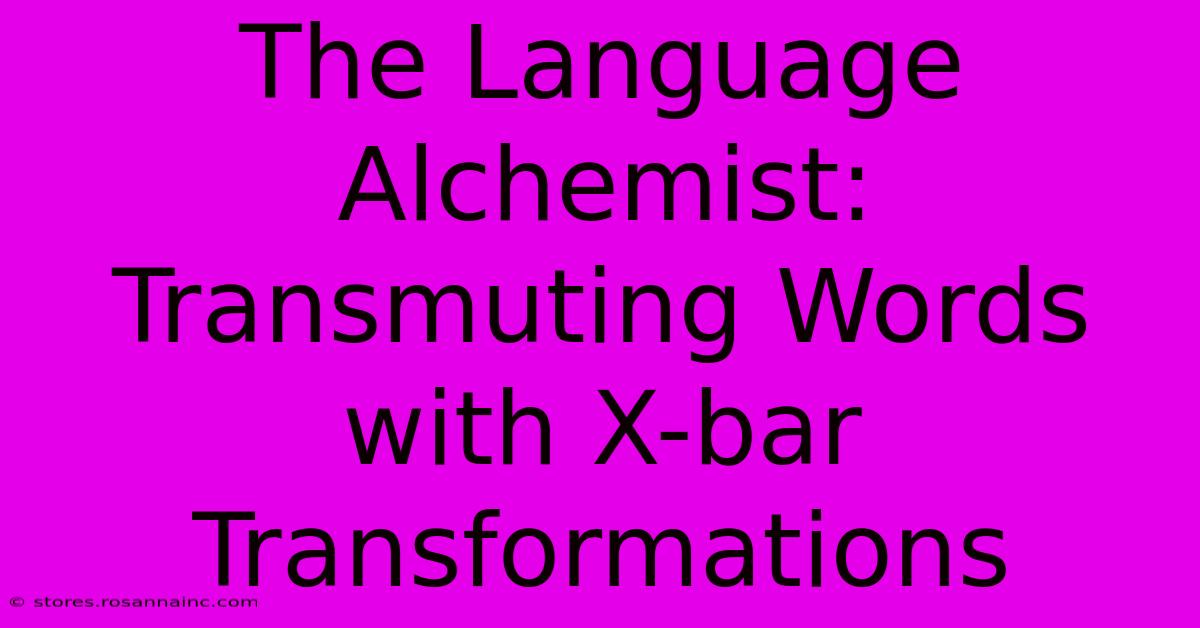The Language Alchemist: Transmuting Words With X-bar Transformations

Table of Contents
The Language Alchemist: Transmuting Words with X-bar Transformations
The world of linguistics can feel like alchemy, transforming raw materials—words and phrases—into complex structures that convey meaning. One particularly potent tool in this linguistic alchemy is X-bar theory, a powerful framework for understanding the internal structure of phrases and sentences. This theory allows us to analyze how seemingly simple words combine to create the intricate tapestry of human language. Let's delve into the magic of X-bar transformations.
Understanding the Basics of X-bar Theory
At its core, X-bar theory is a system for representing the hierarchical structure of phrases. It proposes that every phrase (noun phrase, verb phrase, prepositional phrase, etc.) has a fundamental structure built around a head (X). This head is the central element, which determines the type of phrase. For example:
- NP (Noun Phrase): The head is a noun. Example: the big red ball (ball is the head).
- VP (Verb Phrase): The head is a verb. Example: quickly ran away (ran is the head).
- PP (Prepositional Phrase): The head is a preposition. Example: in the garden (in is the head).
The X-bar schema typically includes:
- X⁰ (X-zero): The head of the phrase. This is the central element.
- X' (X-bar): An intermediate projection, combining the head with complements and other elements.
- XP (X-phrase): The maximal projection, the complete phrase. This includes the X-bar and specifiers (like determiners or adverbs).
The Transformative Power of X-bar: Building Complex Structures
The beauty of X-bar theory lies in its ability to represent the hierarchical and recursive nature of language. Let's consider an example:
- The cat sat on the mat.
Using X-bar theory, we can break this sentence down into its constituent phrases:
- NP (The cat): This NP consists of a determiner ("The") and a head noun ("cat").
- VP (sat on the mat): This VP contains the head verb ("sat") and a PP ("on the mat").
- PP (on the mat): This PP has the head preposition ("on") and a complement NP ("the mat").
This reveals a layered structure, with smaller phrases embedded within larger ones. This hierarchical arrangement is crucial for understanding how meaning is constructed. The X-bar structure explicitly displays the relationships between words and phrases, providing a clear picture of how components combine to form a meaningful sentence.
Specifiers, Complements, and Adjuncts: The Building Blocks
Beyond the head, X-bar theory incorporates other key elements:
- Specifiers: These elements precede the head and modify it (e.g., the determiner "the" in "the cat").
- Complements: These elements follow the head and are essential to the meaning of the head (e.g., "the mat" in "sat on the mat").
- Adjuncts: These elements are optional modifiers that can be added to the phrase (e.g., adverbs modifying the verb).
By combining these elements in different ways, X-bar theory allows us to generate a vast array of possible sentences, reflecting the generative capacity of human language.
Beyond the Basics: Advanced Applications of X-bar Theory
X-bar theory is not just a descriptive tool; it's a powerful framework for understanding linguistic phenomena such as:
- Movement: X-bar theory helps explain transformations like wh-movement (e.g., "What did the cat eat?") and subject-verb inversion in questions.
- Ambiguity: It clarifies how different structural interpretations can lead to ambiguous sentences.
- Cross-linguistic comparisons: It provides a consistent framework for comparing the syntactic structures of different languages.
Conclusion: The Enduring Legacy of X-bar
X-bar theory, despite its apparent complexity, offers a clear and elegant way to understand the structure of phrases and sentences. Its ability to represent hierarchical relationships, recursive structures, and transformations makes it an invaluable tool for linguists and anyone interested in the fascinating intricacies of human language. It truly is the language alchemist's secret formula for transmuting words into meaningful expressions. Mastering X-bar theory unlocks a deeper understanding of the magic behind the sentences we speak and write every day.

Thank you for visiting our website wich cover about The Language Alchemist: Transmuting Words With X-bar Transformations. We hope the information provided has been useful to you. Feel free to contact us if you have any questions or need further assistance. See you next time and dont miss to bookmark.
Featured Posts
-
The Ethereal Beauty Of Flowers Unbound Unfurling Natures Masterpiece
Feb 06, 2025
-
Three Perspectives Interweave A Triptych Of Lives Uncovered
Feb 06, 2025
-
The True Story Behind Raider Rushs Iconic Dance Moves
Feb 06, 2025
-
Revolutionize Business Communication The Ultimate Guide To Email Hosting On Your Domain
Feb 06, 2025
-
Get Your Daily Dose Of Logo Inspiration Eli Lillys Masterclass In Identity
Feb 06, 2025
